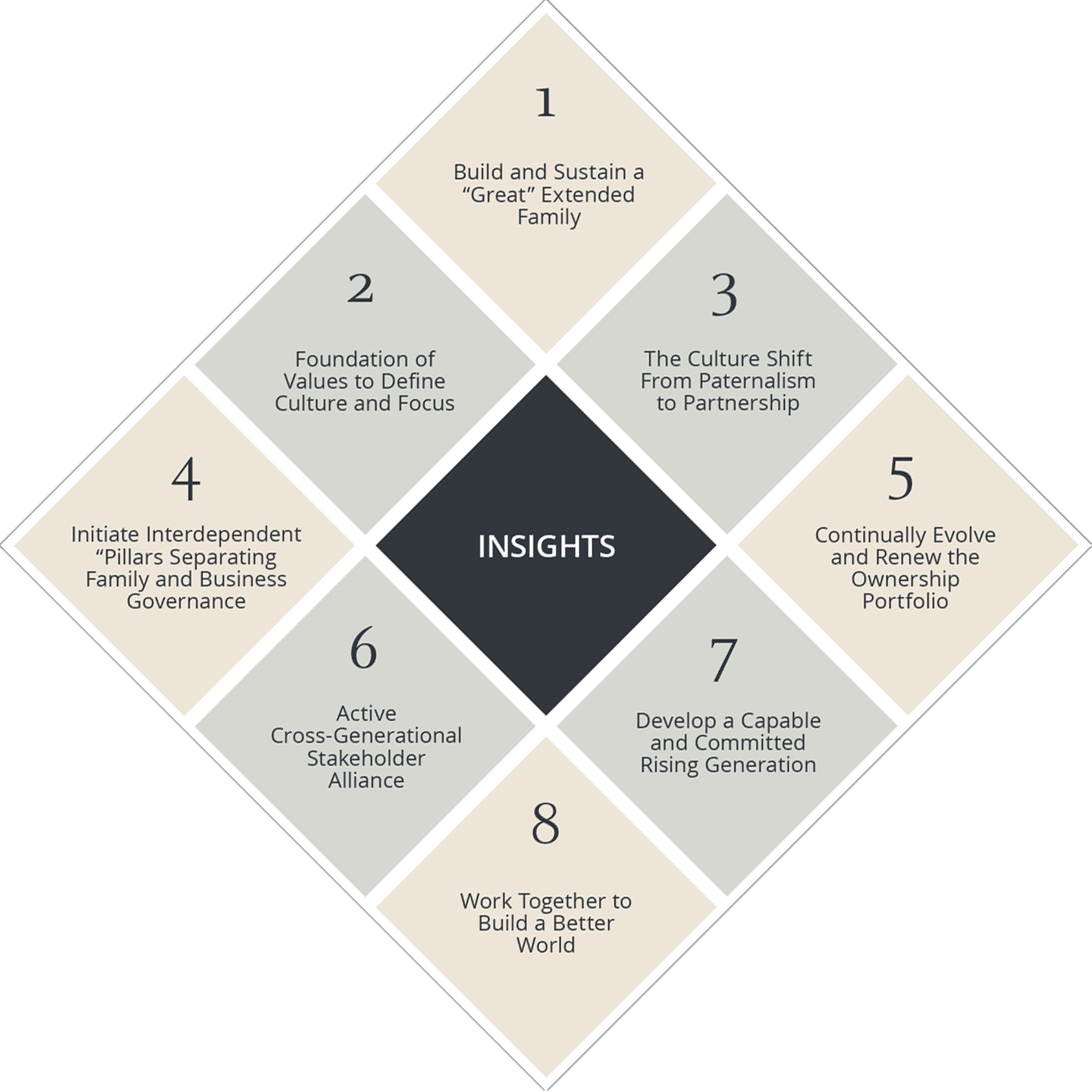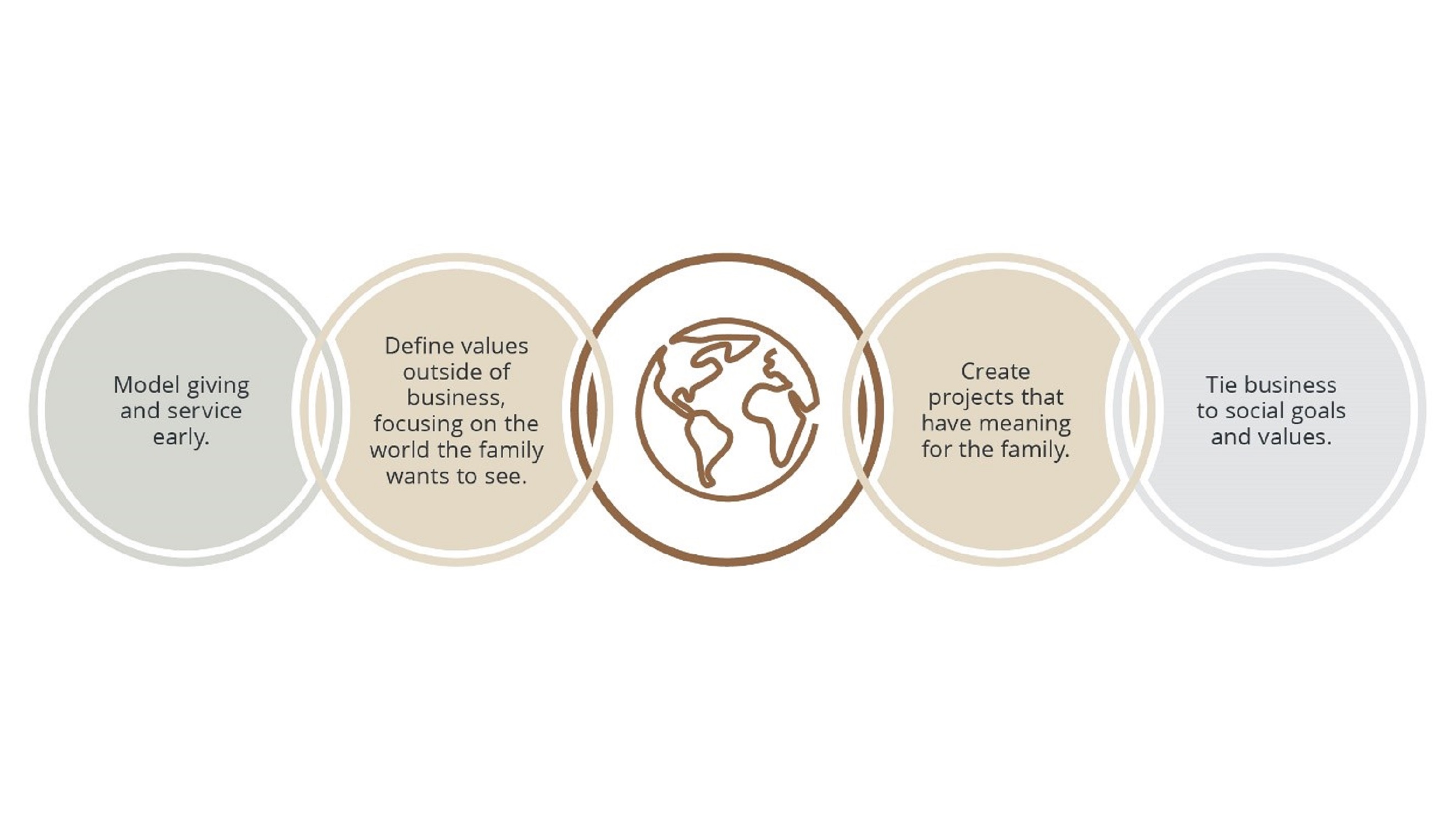
Contributors

Managing Director, Head of Family Engagement and Governance
A series with Dennis T. Jaffe, Ph.D., in partnership with J.P. Morgan Wealth Management’s Family Engagement and Governance team.
Dr. Jaffe, a Senior Research Fellow at BanyanGlobal Family Wealth Advisors, is a leader and an author in the field of family enterprise consulting. An organizational consultant and a clinical psychologist, he helps multigenerational families develop governance practices that build the capability of next-generation leadership and advises financial organizations and family offices on serving family clients.
J.P. Morgan is honored to share a special series highlighting Dr. Jaffe’s findings from his 2021 book, “Borrowed From Your Grandchildren: The Evolution of 100-Year Family Enterprises.”

A key question preoccupying generative families is, “When you have great wealth, what is it to be used for?” The whole family is concerned about the impact of their wealth on the world and how their business and resources make a difference in the world.
Rising generation family members, particularly, are often less interested in the family enterprise unless they can work together in service of a larger social impact. The generative family sees social impact not just as philanthropic activities, but in the values they espouse for their investments.
The philanthropic spirit is the key component of the whole thing to make sure that we never forget where we came from and that giving back is a key thing in the puzzle, and that’s not only an opportunity to a certain degree – it’s a family obligation.
This spirit takes several forms in business families:
- Philanthropic efforts, including creating charitable foundations, as a family and with the business
- Defining social responsibility and affirming values for family enterprises
- Impact of investment and aligning values and profitability
While these seem discrete and different, a generative family sees them as connected and finds ways to have social impact in all of them.
By the third generation, the family focus often shifts to social values and activities done by the family as:
- A visible way to give back and create a sustainable future for their grandchildren
- A shared passion that draws new family members together
- A setting for next-generation learning and development
These activities align the public and private family; the personal commitment of family members gives the family meaning and identity, and this identity becomes a public statement of who the family is and their social commitment, as these two accounts illustrate:
You have to decide what and how we’re going to create added value for humanity, for people. Then we come back to responsibility – if the family decides you have to maximize making money, that’s easy and then you can do anything. My grandmother always told me: Never do it for money because you will never be successful or have enough. You aim to create added value for the people around you. If you do that well and better than anybody else, then you will make money.
Money is a consequence; it cannot be a target. Our company should be part of the solution of the world problems, not part of the problem.

The family’s values can be expressed through philanthropy, corporate social responsibility and impact investing. These activities offer pathways for the family to work together across generations while serving others; they can even furnish career options for young family members.
A common theme among our generative families was gratitude and responsibility to give back. A family philanthropist notes: “The first question I always ask is, ‘Why are you doing this?’ It all starts with a sense of gratitude. They feel there have been blessings and gifts they’ve received. They’re grateful for those gifts, they’re grateful for those who made them possible, and they want to give back.”
One family leader echoes the sentiments of many in expressing the naturalness of this attitude: “Earlier generations made a lot of money and gave back a lot of money. So, this is a family value that has endured – we’ve always had a foundation and always contributed to the community. We reinforce this by having a community service project.”
The visible and tangible expression of values in the community has a deep impact on the family as well. The giving focus offers a way for the family to contribute to projects that make a difference by working together. They are a pathway for involvement that offers opportunity for family members who are not part of the business, and a way for the family to build positive connection and express who they are. Family philanthropy and social purpose are held as the core reasons that a family is able to sustain unity and commitment across generations.
Generative families extend their definition of family to include nonfamily advisors, employees and community members. “We offer a decent job to more than 1,000 employees on our farm and help their families put food on the table. To make our surrounding community healthier and more secure, we are constantly looking for innovative ideas to give back and help decrease unemployment.”
Working together as a family to do good, particularly in one’s community, becomes a powerful win-win, benefiting not only those to whom the service is directed but also the family as a whole. It deepens family relationships and brings families the joy of making a positive difference in the world. This is particularly impactful for the rising generation, giving them a sense of their ability to effect positive change in the world.
Some families tend to go on service vacations, offering help in community projects. One family recalls a trip to China with some as young as preteens. They saw the social challenges facing China in the early stages of its development. It was a trip that became a learning touchstone for the family, helping them define a global focus for their philanthropy.
Typically, successful families who survive beyond their third generation attend to the care and development of their family and their business. They consider this internal investment one of the most important ways to use their wealth. While business savvy and adaptability are important, they view the foundation of future success lying within their extended family and nonfinancial capital – including the development of the character, capability and commitment of each new generation.
Learnings from long-lasting global business families
Below are key actions generative families take to foster a sense of mission and strong values in the rising generation.
Model giving and service early
The family demonstrates commitment to service in their community by doing projects together, by sharing projects and commitments by the family and by talking about what is needed in the world.
They teach their children to contribute financially and personally.
Define values outside of business, focusing on the world the family wants to see
Families talk about the challenges, inequality and pain they see in the world, and their own role as people with advantages to make a difference.
They talk about the responsibility and expectations they experience, and what a responsible person can do to make the world a better place. They encourage each person to define their own values and take steps to make them real.
Create projects that have meaning for the family together
The families expressed their shared values by taking on specific projects, where they contribute resources, time and energy to make an impact. They align over several shared goals and enjoy working together to contribute. This provides an opportunity for generations to work together.
Tie business to social goals and values
Their values are not disconnected from their business and financial behavior. They want the values and behavior expressed in their economic activities to be aligned with their values. They look at the social impact of their investments and their business behavior, and actively seek ways to increase their positive impact on the world.
Read all eight insights
Intro: 8 Insights From Long-lasting Global Business Families
Insight 1: Build and Sustain a “Great” Extended Family
Insight 2: Foundation of Values to Define Culture and Focus
Insight 3: The Culture Shift from Paternalism to Partnership
Insight 4: Initiate Interdependent “Pillars” Separating Family and Business Governance
Insight 5: Continually Evolve and Renew the Ownership Portfolio
Insight 6: Active Cross-Generational Stakeholder Alliance
Insight 7: Develop a Capable and Committed Rising Generation
Connect with a Wealth Advisor
Reach out to your Wealth Advisor to discuss any considerations for your current portfolio. If you don’t have a Wealth Advisor, click here to tell us about your needs and we’ll reach out to you.
IMPORTANT INFORMATION
This material is for informational purposes only, and may inform you of certain products and services offered by J.P. Morgan’s wealth management businesses, part of JPMorgan Chase & Co. (“JPM”). Products and services described, as well as associated fees, charges and interest rates, are subject to change in accordance with the applicable account agreements and may differ among geographic locations. Not all products and services are offered at all locations. If you are a person with a disability and need additional support accessing this material, please contact your J.P. Morgan team or email us at accessibility.support@jpmorgan.com for assistance. Please read all Important Information.
GENERAL RISKS & CONSIDERATIONS. Any views, strategies or products discussed in this material may not be appropriate for all individuals and are subject to risks. Investors may get back less than they invested, and past performance is not a reliable indicator of future results. Asset allocation/diversification does not guarantee a profit or protect against loss. Nothing in this material should be relied upon in isolation for the purpose of making an investment decision. You are urged to consider carefully whether the services, products, asset classes (e.g. equities, fixed income, alternative investments, commodities, etc.) or strategies discussed are suitable to your needs. You must also consider the objectives, risks, charges, and expenses associated with an investment service, product or strategy prior to making an investment decision. For this and more complete information, including discussion of your goals/situation, contact your J.P. Morgan representative.
NON-RELIANCE. Certain information contained in this material is believed to be reliable; however, JPM does not represent or warrant its accuracy, reliability or completeness, or accept any liability for any loss or damage (whether direct or indirect) arising out of the use of all or any part of this material. No representation or warranty should be made with regard to any computations, graphs, tables, diagrams or commentary in this material, which are provided for illustration/reference purposes only. The views, opinions, estimates and strategies expressed in this material constitute our judgment based on current market conditions and are subject to change without notice. JPM assumes no duty to update any information in this material in the event that such information changes. Views, opinions, estimates and strategies expressed herein may differ from those expressed by other areas of JPM, views expressed for other purposes or in other contexts, and this material should not be regarded as a research report. Any projected results and risks are based solely on hypothetical examples cited, and actual results and risks will vary depending on specific circumstances. Forward-looking statements should not be considered as guarantees or predictions of future events.
Nothing in this document shall be construed as giving rise to any duty of care owed to, or advisory relationship with, you or any third party. Nothing in this document shall be regarded as an offer, solicitation, recommendation or advice (whether financial, accounting, legal, tax or other) given by J.P. Morgan and/or its officers or employees, irrespective of whether or not such communication was given at your request. J.P. Morgan and its affiliates and employees do not provide tax, legal or accounting advice. You should consult your own tax, legal and accounting advisors before engaging in any financial transactions.
Legal Entity and Regulatory Information.
J.P. Morgan Wealth Management is a business of JPMorgan Chase & Co., which offers investment products and services through J.P. Morgan Securities LLC (JPMS), a registered broker-dealer and investment adviser, member FINRA and SIPC. Insurance products are made available through Chase Insurance Agency, Inc. (CIA), a licensed insurance agency, doing business as Chase Insurance Agency Services, Inc. in Florida. Certain custody and other services are provided by JPMorgan Chase Bank, N.A. (JPMCB). JPMS, CIA and JPMCB are affiliated companies under the common control of JPMorgan Chase & Co. Products not available in all states.
Bank deposit accounts and related services, such as checking, savings and bank lending, are offered by JPMorgan Chase Bank, N.A. Member FDIC.
This document may provide information about the brokerage and investment advisory services provided by J.P. Morgan Securities LLC (“JPMS”). The agreements entered into with JPMS, and corresponding disclosures provided with respect to the different products and services provided by JPMS (including our Form ADV disclosure brochure, if and when applicable), contain important information about the capacity in which we will be acting. You should read them all carefully. We encourage clients to speak to their JPMS representative regarding the nature of the products and services and to ask any questions they may have about the difference between brokerage and investment advisory services, including the obligation to disclose conflicts of interests and to act in the best interests of our clients.
J.P. Morgan may hold a position for itself or our other clients which may not be consistent with the information, opinions, estimates, investment strategies or views expressed in this document. JPMorgan Chase & Co. or its affiliates may hold a position or act as market maker in the financial instruments of any issuer discussed herein or act as an underwriter, placement agent, advisor or lender to such issuer.








